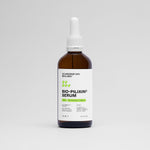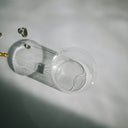Thinning crown is a common concern for many individuals experiencing hair loss. This condition can affect both men and women, leading to a decrease in self-confidence and overall satisfaction with one's appearance. Understanding the causes, symptoms, and potential solutions for a thinning crown can empower individuals to take proactive steps towards addressing this issue. In this article, we will explore the intricacies of a thinning crown, including its causes, treatment options, and preventative measures.
Table of content
What is a thinning crown?
A thinning crown refers to a noticeable reduction in hair density at the crown area of the scalp, which is typically the top section of the head. This condition can manifest as a widening part, patchy hair loss, or overall thinning of hair, leading to a less voluminous appearance. Thinning hair at the crown can be attributed to various factors, including genetics, hormonal changes, stress, and certain medical conditions. It is essential to identify the underlying cause to determine the best course of action for treatment and prevention.
As your leading source for hair health information over the past 4 years, we never compromise on accuracy. When it comes to your health, you deserve information you can truly rely on - and earning your trust is our top priority.
Here's how Scandinavian Biolabs ensures every piece of content meets the highest standards of accuracy and integrity:
- Credentialed Experts: Our reviewers are actively practicing doctors and medical researchers
- Stringent Reviews: Content undergoes rigorous editing by subject specialists and review by a practicing doctor.
- Evidence-Based: We rely on well-established research from trusted scientific sources like peer-reviewed journals and health authorities.
- Full Transparency: Our editorial standards, writer credentials, reviewer credentials, correction process, and funding are all publicly documented.
- Independent Voice: While we do promote products, we operate in a vacuum to business operations. Our main goal is just an unwavering commitment to providing medically-sound guidance.
You can count on Scandinavian Biolabs to consistently deliver the trustworthy health information you deserve. Read our Editorial Standards.
What causes a thinning crown?
Several factors can contribute to a thinning crown, and understanding these causes is crucial for addressing the issue effectively. Here are some of the most common causes:
- Genetics: One of the leading causes of hair thinning is hereditary hair loss, often referred to as androgenetic alopecia. This genetic condition affects both men and women and typically results in a receding hairline and thinning at the crown.
- Hormonal Changes: Hormonal fluctuations, particularly those associated with menopause, pregnancy, or thyroid disorders, can lead to hair thinning. In women, estrogen levels decrease during menopause, which can contribute to hair loss at the crown.
- Stress: Physical or emotional stress can trigger hair loss through a condition known as telogen effluvium, where hair follicles enter a resting phase and subsequently shed more easily.
- Nutritional Deficiencies: A lack of essential nutrients, such as iron, vitamin D, and biotin, can negatively impact hair health and contribute to thinning at the crown.
- Medical Conditions: Certain medical conditions, such as alopecia areata or scalp infections, can lead to hair loss in specific areas, including the crown.
What are the symptoms of a thinning crown?
Identifying the symptoms associated with a thinning crown is essential for early intervention. Common symptoms include:
- Widening Part: A noticeable widening of the hair part can indicate thinning at the crown.
- Increased Hair Shedding: Finding more hair on your brush or in the shower can be a sign of thinning hair.
- Patches of Hair Loss: Developing bald patches or areas of noticeable thinning can occur at the crown.
- Overall Decreased Volume: A general reduction in hair volume and fullness may become apparent.
How can you treat a thinning crown?
There are various treatment options available for those experiencing a thinning crown. The appropriate treatment will depend on the underlying cause of the hair loss. Here are some commonly recommended options:
- Minoxidil: This over-the-counter topical treatment is FDA-approved for hair loss and can help stimulate hair growth in the crown area.
- Finasteride: A prescription medication for men that can help slow hair loss and promote regrowth by blocking the hormone responsible for hair thinning.
- Hair Transplant Surgery: For more severe cases, surgical options like hair transplant may be considered, where hair follicles are moved from a donor site to the thinning crown.
- Platelet-Rich Plasma (PRP) Therapy: This emerging treatment involves injecting concentrated platelets from your blood into the scalp to promote hair growth.
- Low-Level Laser Therapy: This non-invasive treatment uses lasers to stimulate hair follicles and improve hair density.
What preventive measures can be taken to avoid a thinning crown?
Preventing a thinning crown is often possible by adopting a proactive approach to hair health. Here are some effective preventive measures:
- Maintain a Balanced Diet: Ensure your diet is rich in vitamins and minerals that support hair health, such as omega-3 fatty acids, zinc, and iron.
- Manage Stress: Implement stress-reduction techniques such as meditation, yoga, or regular exercise to minimize the impact of stress on hair loss.
- Avoid Harsh Hair Treatments: Limit the use of chemical treatments and heat styling tools that can weaken hair and contribute to thinning.
- Regular Scalp Care: Keep the scalp clean and healthy by using gentle shampoos and conditioners. Scalp massages can also promote blood circulation.
- Consult with a Professional: Regular check-ups with a dermatologist or trichologist can help monitor hair health and address any issues early on.
In conclusion, a thinning crown can be a distressing issue for many individuals. However, by understanding its causes, recognizing the symptoms, and exploring treatment and prevention options, individuals can take control of their hair health. Whether through lifestyle changes, medical treatments, or professional consultations, addressing a thinning crown early can lead to improved outcomes and renewed confidence.
Tired of Thinning Hair? Try a Clinically Tested Serum.
Looking for a natural way to regrow hair and achieve a thicker, fuller head of hair? Ditch the stinging nettle for hair loss – Bio-Pilixin Serum is a drug-free hair activation serum that delivers clinically tested results.
Here's why Bio-Pilixin is superior:
- Clinically Tested Results: 93% of users saw a reduction in hair loss, and 73% experienced increased hair density.
- Safe and Natural: Unlike harsh chemicals, Bio-Pilixin uses plant growth factors derived from stem cell technology to nourish hair follicles and stimulate growth.
- Fast-Acting: See visible results in as little as 45 days (most typically see results within 150 days).
Stop wasting time on unproven remedies. Bio-Pilixin is the safe & effective serum you've been searching for.
Read more:






